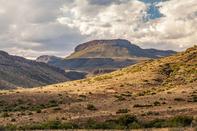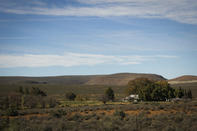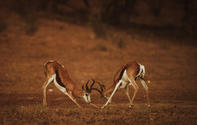When Dinosaurs Roamed
The geological history of the Karoo is remarkable, despite it being such an arid region. It may be difficult to picture, the Karoo was once a forested swamp region inhabited by dinosaurs and other creatures that are now mostly extinct.

Now, 125 to 250 million years later, the dry Karoo has become a graveyard for the fossilised skeletons of these terrible lizards, making it one of the richest deposits of fossils in the world. After the dinosaurs died out, they were succeeded by the herds of game we are familiar with today. Springbok, black wildebeest, red hartebeest, kwagga, blesbok and eland flourished on the plains.
The game did not appear when the Karoo looked like it does today, but rather during a period of transition where there was slightly more surface water around. The dry spells that came thinned out their numbers considerably and was further diminished by those who hunted to fill their stores of meat and leather without considering that numbers are exhaustible.
A Threat to the Animals

When settlers came to the Karoo the government allocated them large sheep-runs to keep their livestock and thus, the area the wild game had to graze and live was greatly reduced. At the time, no one understood that the wild game in the Karoo was an asset to South Africa and so did not consider planning and settling in such a way that coexistence was possible. The sheep-runs built took up a lot of space and were fenced off with barbed wire.
The wild game, now with their movement restricted and vegetation dwindling found themselves facing extinction. Eventually people became aware of the threat to the indigenous animals and felt the need to protect them. These people were first dismissed as a small group of nut-jobs, meanwhile the natural wilderness areas of South Africa were falling below 10% of the total land area. A movement was started in Beaufort West by a farmer and bird-lover named William Quinton with the aim of establishing a conservation area.
With support from the National Parks Board and South African Nature Foundation, Beaufort West municipality donated 7 209 ha of land to become the nucleus of a national park. The Nature Foundation and some private bodies assisted in raising additional funds.
Karoo National Park Proclaimed

The Karoo National Park was proclaimed in 1979, made up of the land donated by the Beaufort West Municipality as well as two other farms called Stolshoek and Buttersvlei. It now covers over 75 000 ha. The ultimate aim of the park is to conserve the natural vegetation and wildlife of the Karoo. Altitudes in the park range from low-lying Karoo plains to mountain slopes as well as high-lying plateau summits.
It contains a multitude of wild mammals, reptiles, birds and indigenous vegetation. Among the large herbivores that can be seen include red hartebeest, eland, zebra, kudu and springbok. Reptiles that can be found include five species of tortoise, terrapins, agamas, chameleons, monitors, snakes, skinks, geckos and lizards. There are over 180 bird species and a fascinating array of flora.
There is also the constant opportunity to discover new species. Accommodation is available and the park is connected to the N1 by a tarred road. Visitors can enjoy 4x4 Eco-Trails, guided game drives, guided walks, a 400 m long fossil trail (which is wheelchair accessible), Sylvester Single Track (for runners and mountain bikers), bird hides and picnic grounds.
 The Karoo, which is the semi-desert region of South Africa, is best experienced from its heart, Beaufort West. Known as the oldest town in t...
The Karoo, which is the semi-desert region of South Africa, is best experienced from its heart, Beaufort West. Known as the oldest town in t... Located in the Great Karoo Area near Beaufort West in the Western Cape, the Karoo National Park covers over 75 000 ha of land dedicated to p...
Located in the Great Karoo Area near Beaufort West in the Western Cape, the Karoo National Park covers over 75 000 ha of land dedicated to p...